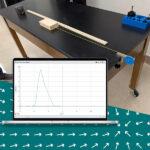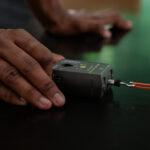
Sharing ideas and inspiration for engagement, inclusion, and excellence in STEM
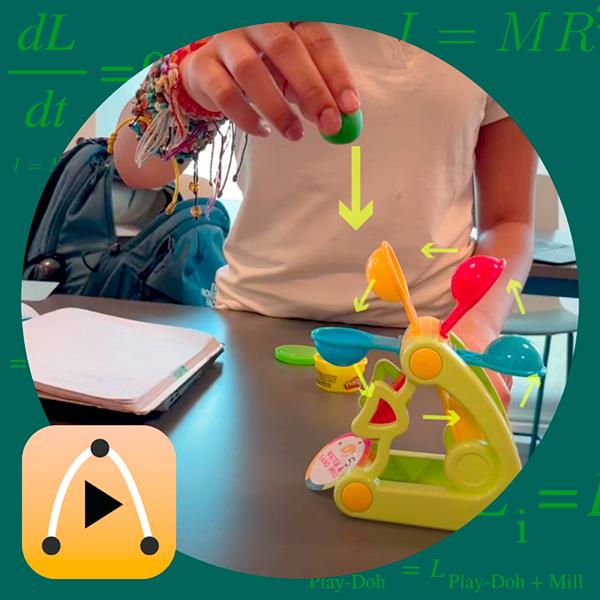
Physics Is Everywhere
British mathematician Roger Penrose once stated, “Sometimes it’s the detours which turn out to be the fruitful ideas.” I am always searching for innovative ways to connect what students are learning in my physics class with the real world.
In late April, during a visit to the Staten Island Target®, a family member yanked my arm so we could “see what cool stuff they had in Bullseye’s Playground,” the area of seasonal products right by the entrance. Amongst the plastic pitchers and 4th of July decor, I spotted the Target plastic Water & Sand Mill, priced at just $1.
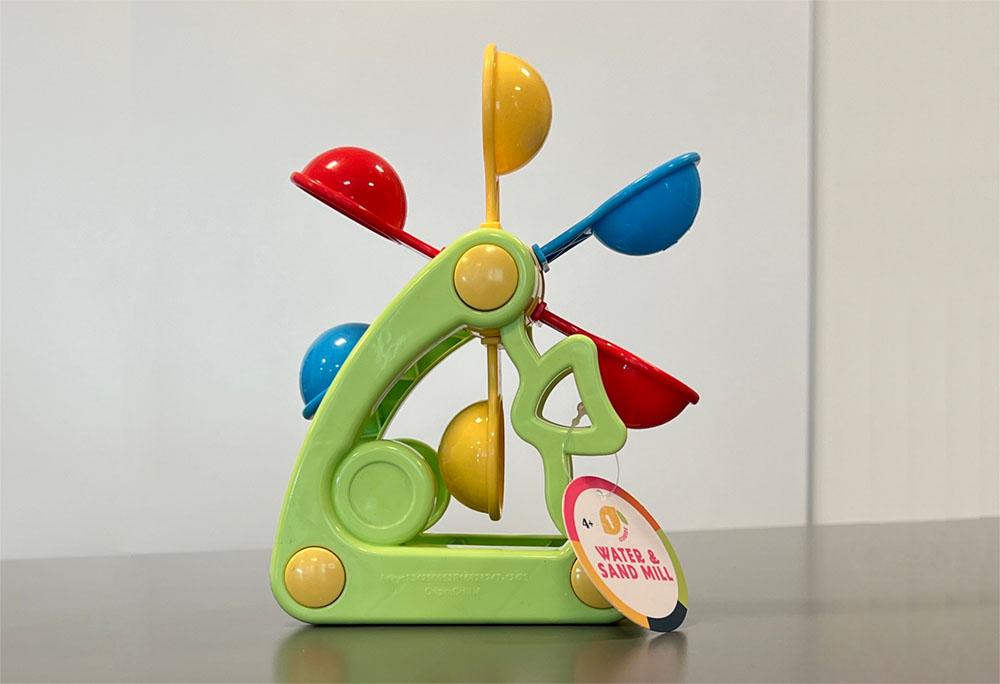
In my physics class, we were studying rotational dynamics. My mind started to spin—pun intended—and I thought, “My students could use the mill, along with some Play-Doh®, to model conservation of angular momentum.” I scooped up every last mill and headed to the toy department to buy some Play-Doh. A new lab activity was born. It was that detour at Target that gave birth to a fruitful lab activity. (Side note: It looks like this product is no longer available at Target, but there are a number of similar waterwheel-style toys you can try like this one.)
Conservation of angular momentum explains why ice skaters start to spin faster when they draw their arms inward. When the ice skater goes into the tuck position, the skater’s rotational inertia decreases, and, as a result, the skater’s rotational velocity increases.
In the Physics Lab
As part of our study of rotation in physics, students analyzed conservation of angular momentum using a Target Water & Sand Mill, Play-Doh, and Vernier Video Analysis®. Their goal: Calculate the experimental mass of the Play-Doh in the angular collision with the Water & Sand Mill (hereon referred to as the “Mill”).
Prep Note: This lab was completed in a grade 11 honors physics class. Prior to the activity, students had discussed and completed calculations for: angular momentum of a point particle, angular momentum of a rotating system, and conservation of angular momentum. The math ability of the students in this class ranges from precalculus to differential equations. The activity may be scaled appropriately based on the level of physics.
For rotational motion, as with linear motion, conservation of angular momentum is an important and useful principle. For a mass system rotating about an axis with no external force acting on it and negligible dissipative forces, angular momentum is conserved.
With the angular momentum of a rotating system represented by L and no external torques acting on the system then L = constant, or

Angular momentum may be expressed as the product of the rotational inertia and the angular velocity, or

At a given point on the Mill, a distance r from the center of rotation, the angular velocity is equal to the point’s tangential velocity, v, divided by the radius, r, or

If you consider the total mass of the Mill, M, being concentrated at a specific distance R from the center of rotation, the rotational inertia of the mass, I, is

Therefore, substituting this into the above equation for angular momentum, you may write the angular momentum of the rotating Mill as

In general, you can write conservation of angular momentum as

For the angular momentum of the system you will analyze, the angular momentum of the falling Play-Doh (yes, it has angular momentum) before the angular collision is equal to the angular momentum of the system after the angular collision, or

This relationship is true if we assume that the Play-Doh stays in the Mill.
Class Discussion Note: In our data analysis discussion during the lab, students raised an important question. Each rotating shape has its own equation for rotational inertia. What shape is the Mill? When non-rotating, the Mill approximates a ring. When rotating, the Mill approximates a solid disk. As such, the procedure and data analysis have been adjusted so that the rotating Mill approximates a solid, rotating disk.
Lab Procedure
1. Measure the mass and diameter of the Mill. You will assume the Mill is a solid, rotating disk with rotational inertia

2. Set up your Mill and mobile device as shown in the demo. The angular collision that occurs is between the falling Play-Doh (a particle of mass m a distance r from the center of rotation of the Mill) and the rotating Mill.
3. The angular momentum of the falling Play-Doh is transferred to the Mill. Therefore, your equation for conservation of angular momentum is

4. Drop the Play-Doh blob from a height of no more than 5 cm. Observe what happens. The blob will, most likely, bounce out of the cup. If so, you may assume that the final angular momentum is zero.
5. Prepare to record the motion of the falling Play-Doh and the subsequent rotating Mill.
6. Repeat for two additional trials.
7. When you have finished, bring your Play-Doh to me. I will record the mass. You will only receive the mass after you have completed your calculations.
Data Needed
Using Vernier Video Analysis, you need to determine the tangential velocity of the Play-Doh just before the angular collision with the Mill and the angular velocity of the Mill just after the angular collision.
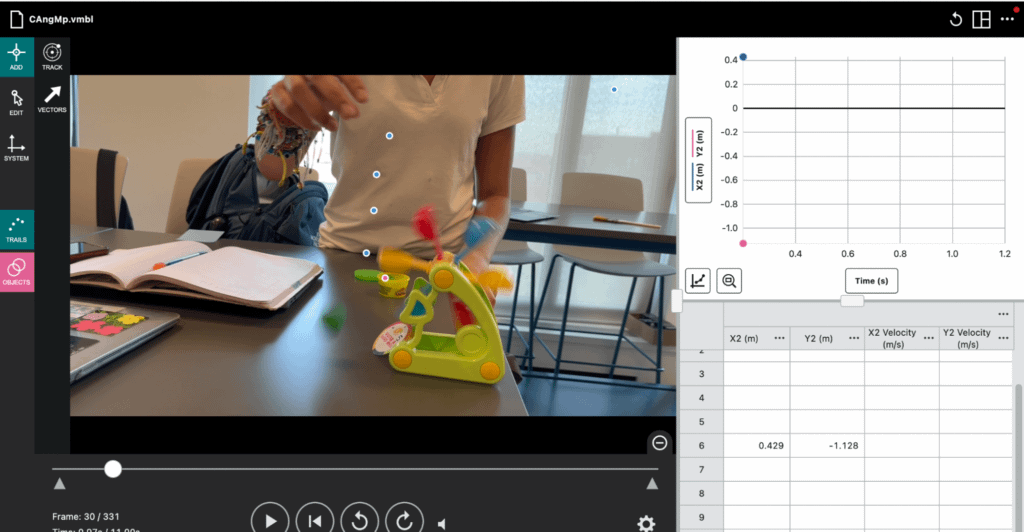
Calculations
The goal of the experiment was to experimentally determine the mass of their Play-Doh. Sample calculations are shown below.
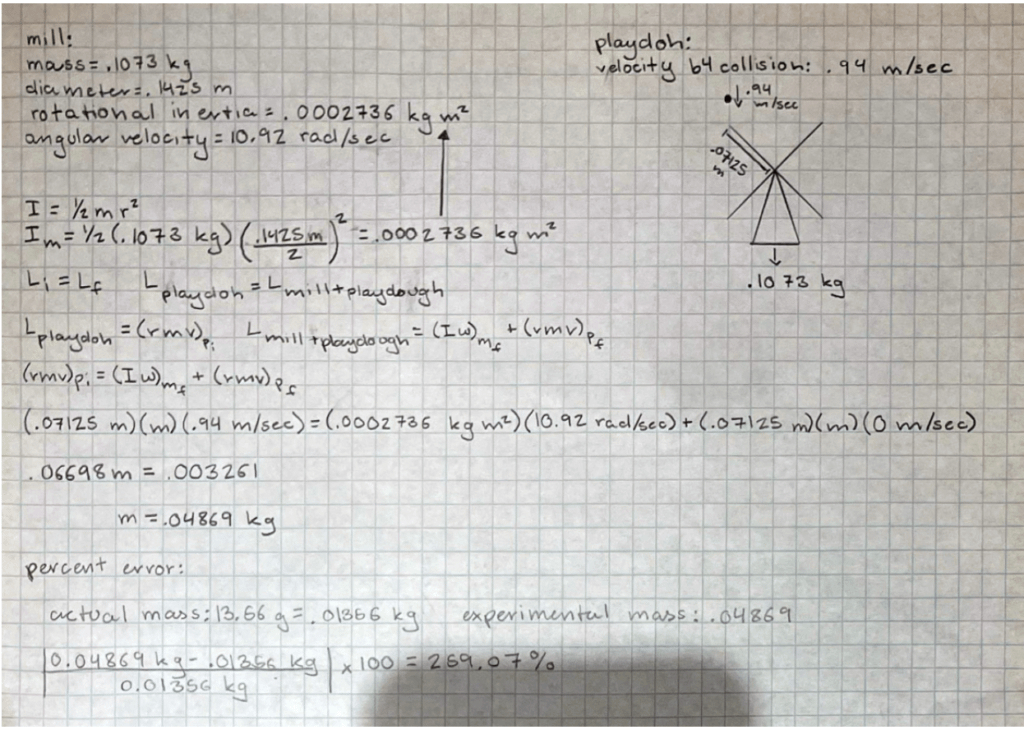
Error Analysis
There are a number of sources of error in this experiment. For example, you assumed that the Mill is a rigid, rotating disk. The Mill is clearly not. Does your assumption result in an experimental mass of the Play-Doh that is too high, too small, or just about right? Justify your answer.
Sample Student Response and Mathematical Proof
“The rotational inertia of the Water & Sand Mill is greater than that of a rotating disk because, compared to the rotating disk, the Water & Sand Mill has more mass distributed farther away from the center of rotation. Because of this, the experimental mass of the Play-Doh that I found is smaller than the actual mass.”

Standards
NGSS
HS-PS2-2.
Use mathematical representations to support the claim that the total momentum of a system of objects is conserved when there is no net force on the system.
HS-PS2-3.
Apply science and engineering ideas to design, evaluate, and refine a device that minimizes the force on a macroscopic object during a collision.
ISTE
Knowledge Constructor. 1.3.d.
Students build knowledge by actively exploring real-world issues and problems, developing ideas and theories, and pursuing answers and solutions.
Innovative Designer. 1.4.d.
Students exhibit a tolerance for ambiguity, perseverance and the capacity to work with open-ended problems
Computational Thinker. 1.5.a.
Students formulate problem definitions suited for technology-assisted methods such as data analysis, abstract models and algorithmic thinking in exploring and finding solutions.
Computational Thinker. 1.5.b.
Students collect data or identify relevant data sets, use digital tools to analyze them and represent data in various ways to facilitate problem-solving and decision-making.
A version of this blog post was originally published on Medium in June 2024.
Eric serves as the Director of STEM Education and teaches physics and atmospheric science classes at Marymount School of New York in NYC. He is also an inaugural member of the Vernier Trendsetters Community, bringing 20+ years of experience in K–12 science education. A longtime Vernier enthusiast, Eric is passionate about empowering his students as data scientists and finding creative ways for students to explore and analyze “physics in the real world.” Outside of the classroom, you can connect with Eric on LinkedIn.
Share this Article

Sign up for our newsletter
Stay in the loop! Beyond Measure delivers monthly updates on the latest news, ideas, and STEM resources from Vernier.



